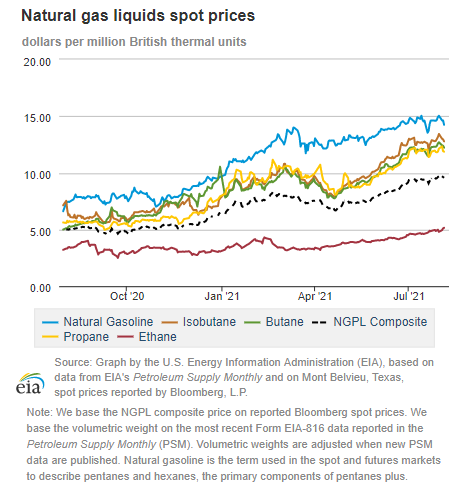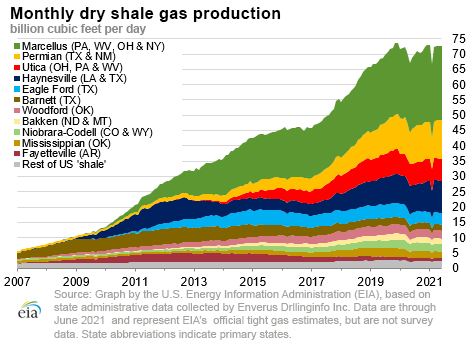In the News:
Brazil increases LNG imports from the United States amid its worst drought in more than 90 years
Brazil is experiencing its worst drought in more than 90 years, leading to increased demand for electricity generation from natural gas-fired power plants to compensate for reduced generation from hydropower. LNG imports, which are typically used to manage fluctuations in Brazil’s demand for natural gas, averaged 0.9 billion cubic feet per day (Bcf/d) and 0.7 Bcf/d in the first and second quarters of 2021 compared with average volumes of 0.2 Bcf/d over the previous five years because of the increased demand from the power generation sector.
Brazil is the world’s 12th-largest economy and relies mainly on hydropower for its power generation needs. In a typical year, 65% of Brazil’s electricity is generated by hydropower plants, 20% by renewables (other than hydropower), 10% by natural gas-fired power plants, and the remaining 5% is split among coal, petroleum, and nuclear generation, according to data from Brazil’s Ministry of Mines and Energy (MME). The power and industrial sectors are the main consumers of natural gas in Brazil. In 2016–2020, power sector demand for natural gas averaged around 1.3 Bcf/d, according to MME data. However, in 2013–2015, when Brazil experienced multi-year drought conditions, natural gas consumption by the power sector increased by 0.5 Bcf/d, or about 37%, and consumption by the industrial sector increased by about 0.1 Bcf/d, or about 12%.
Over 90% of Brazil’s LNG import volumes in the first half of 2021 were from the United States. The 2021 quarterly LNG import values were the second-largest since 2015, when Brazil’s LNG imports were at all-time highs, according to Brazil Ministry of Economy’s foreign trade statistics (Comex Stat). Because of variability in demand for LNG imports, Brazil has no term contracts and procures LNG supplies in the global spot markets. In the last three years, most of Brazil’s LNG imports were sourced from the United States and Trinidad & Tobago.
In 2020, domestically produced dry natural gas accounted for approximately 76% (2.5 Bcf/d) of the total domestic supply, while pipeline imports from Bolivia accounted for 20% (0.6 Bcf/d), and LNG imports for 4% (0.1 Bcf/d), according to data from Brazil’s National Agency for Petroleum, Natural Gas and Biofuels. Pipelines that deliver domestically produced natural gas and imports from Bolivia are generally utilized at full capacity, while utilization of LNG import capacity in a typical year ranges from 20% to 30%. During the previous multi-year drought (2013–2015), LNG import capacity utilization averaged around 65%.
Brazil uses offshore Floating Storage and Regasification Units (FSRUs) to import LNG, which allows flexibility to move FSRU vessels between ports with existing FSRU infrastructure based on seasonal needs. The combined regasification capacity of Brazil’s four active FSRUs is 2.7 Bcf/d. Two of these FSRUs (each with a capacity of 0.7 Bcf/d) were commissioned last year as part of integrated LNG-to-power projects to serve new natural gas-fired power plants with a combined capacity 4.4 gigawatts (GW), according to the International Group of Liquefied Natural Gas Importers (GIIGNL). The first LNG cargo was transferred to the Golar Nanook FSRU at the Porto de Sergipe I in February 2020 and to BW Magna FSRU at the Port of Açu in December 2020. However, Porto de Sergipe I had not received any LNG cargoes in the first six months of this year, and Brazil’s overall LNG import capacity utilization in the first six months of 2021 averaged 30%.
Overview:
(For the week ending Wednesday, August 4, 2021)
- Natural gas spot prices rose at most locations this report week (Wednesday, July 28 to Wednesday, August 4). The Henry Hub spot price rose from $4.05 per million British thermal units (MMBtu) last Wednesday to $4.12/MMBtu yesterday.
- The August 2021 NYMEX contract expired last Wednesday at $4.044/MMBtu. The September 2021 NYMEX contract price increased to $4.158/MMBtu, up 12¢/MMBtu from last Wednesday to yesterday. The price of the 12-month strip averaging September 2021 through August 2022 futures contracts climbed 10¢/MMBtu to $3.854/MMBtu.
- Net injections to working gas totaled 13 billion cubic feet (Bcf) for the week ending July 30. Working natural gas stocks totaled 2,727 Bcf, which is 17% lower than the year-ago level and 6% lower than the five-year (2016–2020) average for this week.
- The natural gas plant liquids composite price at Mont Belvieu, Texas, rose by 14¢/MMBtu, averaging $9.64/MMBtu for the week ending August 4. Ethane prices rose 2%, while average natural gas prices on the Houston Ship Channel remained flat week over week, causing the premium for ethane over natural gas on a heat-content-equivalent basis to rise by 10%. Ethane prices are now at the highest levels since early 2019, pushed up by rising ethylene prices, which rose 5% week over week, and are now at the highest level since the first week of May. Propane and isobutane prices rose 2%, and normal butane prices rose 1% despite the 1% decrease in Brent crude oil prices, as continuing strong international demand for liquefied petroleum gases (LPG) sustains elevated U.S. exports of these fuels. Natural gasoline prices remained relatively unchanged.
- According to Baker Hughes, for the week ending Tuesday, July 27, the natural gas rig count decreased by 1 to 103. The number of horizontal natural-gas-directed rigs increased by 1 each in Ohio and in Pennsylvania and was offset by declines in vertical /directional rigs drilling for natural gas in other states. The number of oil-directed rigs fell by 2 to 385. Similar to natural gas rigs, the number of horizontal rigs increased, with strong gains in the Permian Basin in Texas, but it was offset by a decline in vertical/directional rigs. The total rig count decreased by 3, and it now stands at 488.
Prices/Supply/Demand:
Gulf Coast prices rise on high demand, below-normal inventories. This report week (Wednesday, July 28 to Wednesday, August 4), the Henry Hub spot price rose 7¢ from $4.05/MMBtu last Wednesday to $4.12/MMBtu yesterday. Rising prices are supported by continuing strong demand from electric power generation and LNG exports. In addition, upward shifts in the futures curve and natural gas inventories below the five-year average may be causing pressure on day-ahead prices, according to trade press.
Midwest prices rise on expectations of higher electric power generation demand as a result of forecasts for above-normal temperatures. At the Chicago Citygate, the price increased 16¢ from $3.86/MMBtu last Wednesday to a weekly high of $4.02/MMBtu yesterday. Prices at the Chicago Citygate declined to a low of $3.70/MMBtu last Friday, as temperatures decreased and natural gas demand for electric power generation declined. The National Oceanic and Atmospheric Administration (NOAA) forecasts a return to above-normal temperatures in the coming week, resulting in upward pressure on natural gas prices.
Prices at both California hubs remain elevated because of above-normal temperatures and pipeline constraints. The price at PG&E Citygate in Northern California rose 4¢, up from $5.55/MMBtu last Wednesday to $5.59/MMBtu yesterday. The price at SoCal Citygate in Southern California decreased 36¢ from $8.31/MMBtu last Wednesday to $7.95/MMBtu yesterday. Prices at the Malin hub on the Oregon/California border, the main northern delivery point into the PG&E service territory, averaged $4.06/MMBtu throughout the week—the highest weekly average since mid-February—and ended the report week at $4.04/MMBtu, 2¢/MMBtu above last Wednesday’s price of $4.02/MMBtu. IHS Markit estimates power generation natural gas demand in the Pacific Northwest to have averaged 1.14 Bcf/d this report week, the second-highest weekly average since August 2016, reducing natural gas volumes available for onward delivery into the California market. Two pipelines delivering into the SoCal service area reported reductions in throughput. A pressure reduction on line 3000 of the SoCal Gas system, which is located on the border of Arizona and Southern California, was announced on August 2. Another pipeline that transports natural gas from the Permian basin to California, the Transwestern pipeline, announced a force majeure on August 3. Offsetting some of the reduced supply into Southern California, SoCal Gas reports maintenance at the Aliso Canyon storage facility beginning July 31, which reduced the ability to inject natural gas for storage by 295 million cubic feet per day (MMcf/d). Normally stocks at Aliso Canyon would build during this time of year, generating additional demand on the system, so the outage has resulted in some spare capacity in the service area. No end-date has been announced by SoCal Gas for the Aliso Canyon maintenance.
Prices rise across the Northeast on expectations of above-average temperatures and strong electric power generation demand. At the Algonquin Citygate, which serves Boston-area consumers, the price went up 79¢ from $3.04/MMBtu last Wednesday to a weekly high of $3.83/MMBtu yesterday. At the Transcontinental Pipeline Zone 6 trading point for New York City, the price increased 63¢ from $3.12/MMBtu last Wednesday to a weekly high of $3.75/MMBtu yesterday. NOAA forecasts over 80% probability of above-normal temperatures in the coming week. Ongoing maintenance on Tennessee Gas Pipeline’s (TGP) Segment 315 has reduced flows along a path that moves natural gas from the Appalachian Basin production area into the New York market. During planned repairs on the Tennessee Gas pipeline near Wellsboro, PA, an issue was discovered that caused a compressor unit to be taken offline, restricting flows by up to 150 MMcf/d.
Prices in the Appalachian Basin rise on higher in-region demand and increased capacity to move natural gas out of the production area. The Tennessee Zone 4 Marcellus spot price increased 89¢ from $2.72/MMBtu last Wednesday to $3.61/MMBtu yesterday. The price at Eastern Gas South in southwest Pennsylvania rose 82¢ from $2.83/MMBtu last Wednesday to $3.65/MMBtu yesterday. Texas Eastern received approval from the Pipeline and Hazardous Materials Safety Administration (PHMSA) to resume normal operations on its southbound 30-inch system of the Texas Eastern Transmission pipeline. In a statement on July 29, Texas Eastern said they anticipated normalized flows to begin on August 4, which will initially increase throughput on the segment to 1.85 Bcf/d, an increase of more than 0.5 Bcf/d over the 1.31 Bcf/d Texas Eastern reported as southbound capacity on August 3. The restrictions on Texas Eastern, which affected flows south of the Berne compressor station, began on June 2, when PHMSA denied Enbridge, the pipeline operator, a waiver extension that permitted the pipeline to operate at normal pressure.
Prices in the Permian Basin production region decline on pipeline takeaway constraints. The price at the Waha Hub in West Texas, which is located near Permian Basin production activities, fell 10¢/MMBtu from $3.92/MMBtu last Wednesday to $3.82/MMBtu yesterday. The Waha discount relative to the Henry Hub expanded from 13¢/MMBtu last Wednesday to 30¢/MMBtu yesterday, because of capacity constraints on pipelines moving natural gas west into the California market (see California section above), along with planned maintenance on Kinder Morgan’s Permian Highway Pipeline (PHP), which transports natural gas southeast out of the Permian Basin to the Houston, Texas area. Maintenance on PHP began on August 3, and is planned to last through August 6, reducing flows by as much as 0.9 Bcf/d on some days.
U.S. overall supply declines 0.2% week over week on slightly lower Canadian imports. According to data from IHS Markit, the average total supply of natural gas fell by 0.2%, or 0.2 Bcf/d, compared with the previous report week. While domestic dry natural gas production grew by 0.1% compared with the previous report week, average imports from Canada decreased by 5.5%, resulting in the net decrease.
U.S. consumption of natural gas fell in all sectors this week except in the industrial sector. Mean temperatures dropped substantially across wide sections of the United States last week, resulting in total U.S. consumption of natural gas falling by 3.8%, or 2.6 Bcf/d, compared with the previous report week, according to data from IHS Markit. Average weekly natural gas consumption for power generation and residential and commercial sectors declined by 7.3% and 2.0% week to week, or 3.0 Bcf/d and 0.2 Bcf/d, respectively. Industrial sector consumption increased by 2.6% week over week, offsetting the previous week’s 1.1% decrease, and ending the week at the highest levels since the last week of May. After holding steady last week, natural gas exports to Mexico decreased 7.5% on average in the current week. Natural gas deliveries to U.S. liquefied natural gas (LNG) export facilities (LNG pipeline receipts) averaged 10.5 Bcf/d, or 0.2 Bcf/d lower than last week.
U.S. LNG exports increase week over week. Twenty one LNG vessels (seven from Sabine Pass, five from Freeport, four each from Cameron and Corpus Christi, and one from Cove Point) with a combined LNG-carrying capacity of 77 Bcf departed the United States between July 29 and August 4, 2021, according to shipping data provided by Bloomberg Finance, L.P.
Storage:
The net injections into storage totaled 13 Bcf for the week ending July 30, compared with the five-year (2016–2020) average net injections of 30 Bcf and last year's net injections of 32 Bcf during the same week. Working natural gas stocks totaled 2,727 Bcf, which is 185 Bcf lower than the five-year average and 542 Bcf lower than last year at this time.
According to a Bloomberg survey of natural gas analysts, estimates of the weekly net change to working natural gas stocks ranged from net injections of 14 Bcf to 22 Bcf, with a median estimate of 18 Bcf.
The average rate of injections into storage is 14% lower than the five-year average so far in the refill season (April through October). If the rate of injections into storage matched the five-year average of 8.7 Bcf/d for the remainder of the refill season, the total inventory would be 3,534 Bcf on October 31, which is 185 Bcf lower than the five-year average of 3,719 Bcf for that time of year.
More storage data and analysis can be found on the Natural Gas Storage Dashboard and the Weekly Natural Gas Storage Report.
See also:
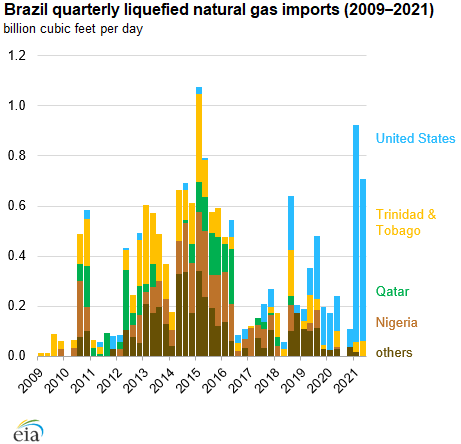 Source: Graph by the U.S. Energy Information Administration (EIA), based on data from from Brazil's Ministério da Economia's Comex Stat system.
Source: Graph by the U.S. Energy Information Administration (EIA), based on data from from Brazil's Ministério da Economia's Comex Stat system.
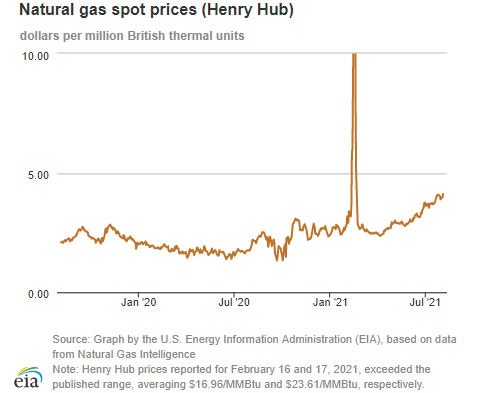
| Spot Prices ($/MMBtu) | Thu, 29-Jul |
Fri, 30-Jul |
Mon, 02-Aug |
Tue, 03-Aug |
Wed, 04-Aug |
|---|---|---|---|---|---|
| Henry Hub |
4.03 |
3.89 |
3.98 |
3.99 |
4.12 |
| New York |
2.84 |
2.90 |
3.24 |
3.62 |
3.75 |
| Chicago |
3.81 |
3.70 |
3.87 |
3.84 |
4.02 |
| Cal. Comp. Avg.* |
5.20 |
5.22 |
5.55 |
5.57 |
5.45 |
| Futures ($/MMBtu) | |||||
| September contract | 4.059 |
3.914 |
3.935 |
4.027 |
4.158 |
| October contract |
4.060 |
3.920 |
3.938 |
4.032 |
4.163 |
| *Avg. of NGI's reported prices for: Malin, PG&E Citygate, and Southern California Border Avg. | |||||
| Source: NGI's Daily Gas Price Index | |||||
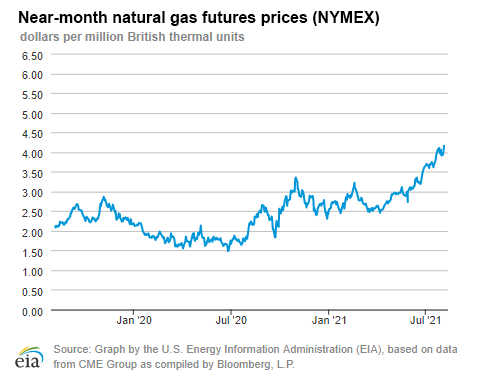
| U.S. natural gas supply - Gas Week: (7/29/21 - 8/4/21) | |||
|---|---|---|---|
Average daily values (billion cubic feet) |
|||
this week |
last week |
last year |
|
| Marketed production | 105.1 |
104.9 |
99.7 |
| Dry production | 93.0 |
92.9 |
89.0 |
| Net Canada imports | 5.2 |
5.5 |
4.7 |
| LNG pipeline deliveries | 0.1 |
0.1 |
0.1 |
| Total supply | 98.3 |
98.5 |
93.8 |
|
Source: Chart by the U.S. Energy Information Administration (EIA), based on data from IHS Markit | |||
| U.S. natural gas consumption - Gas Week: (7/29/21 - 8/4/21) | |||
|---|---|---|---|
Average daily values (billion cubic feet) |
|||
this week |
last week |
last year |
|
| U.S. consumption | 66.5 |
69.1 |
72.5 |
| Power | 37.8 |
40.8 |
43.5 |
| Industrial | 20.6 |
20.0 |
21.0 |
| Residential/commercial | 8.1 |
8.3 |
7.9 |
| Mexico exports | 5.9 |
6.3 |
5.8 |
| Pipeline fuel use/losses | 6.3 |
6.4 |
6.4 |
| LNG pipeline receipts | 10.5 |
10.7 |
3.6 |
| Total demand | 89.2 |
92.6 |
88.4 |
|
Source: Chart by the U.S. Energy Information Administration (EIA), based on data from IHS Markit | |||
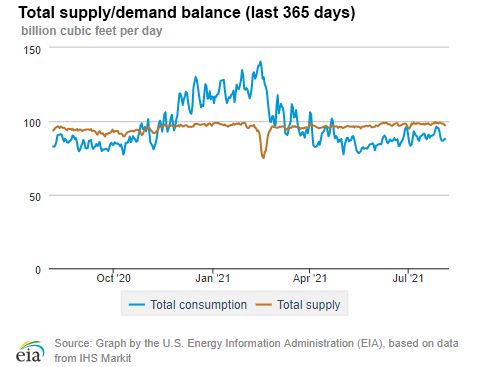
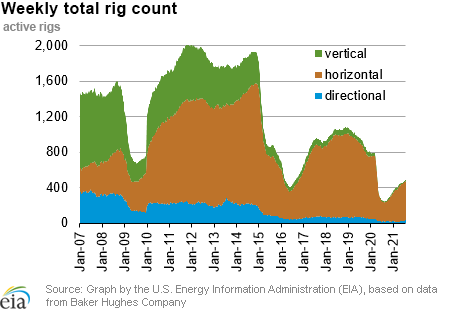
| Rigs | |||
|---|---|---|---|
Tue, July 27, 2021 |
Change from |
||
last week |
last year |
||
| Oil rigs | 385 |
-0.5% |
113.9% |
| Natural gas rigs | 103 |
-1.0% |
49.3% |
| Note: Excludes any miscellaneous rigs | |||
| Rig numbers by type | |||
|---|---|---|---|
Tue, July 27, 2021 |
Change from |
||
last week |
last year |
||
| Vertical | 17 |
-10.5% |
30.8% |
| Horizontal | 442 |
0.7% |
104.6% |
| Directional | 29 |
-12.1% |
31.8% |
| Source: Chart by the U.S. Energy Information Administration (EIA), based on data from Baker Hughes Company | |||
| Working gas in underground storage | ||||
|---|---|---|---|---|
Stocks billion cubic feet (Bcf) |
||||
| Region | 2021-07-30 |
2021-07-23 |
change |
|
| East | 604 |
583 |
21 |
|
| Midwest | 719 |
702 |
17 |
|
| Mountain | 184 |
184 |
0 |
|
| Pacific | 244 |
246 |
-2 |
|
| South Central | 976 |
999 |
-23 |
|
| Total | 2,727 |
2,714 |
13 |
|
|
Source: U.S. Energy Information Administration Form EIA-912, Weekly Underground Natural Gas Storage Report | ||||
| Working gas in underground storage | |||||
|---|---|---|---|---|---|
Historical comparisons |
|||||
Year ago (7/30/20) |
5-year average (2016-2020) |
||||
| Region | Stocks (Bcf) |
% change |
Stocks (Bcf) |
% change |
|
| East | 716 |
-15.6 |
655 |
-7.8 |
|
| Midwest | 828 |
-13.2 |
734 |
-2.0 |
|
| Mountain | 201 |
-8.5 |
184 |
0.0 |
|
| Pacific | 311 |
-21.5 |
287 |
-15.0 |
|
| South Central | 1,214 |
-19.6 |
1,053 |
-7.3 |
|
| Total | 3,269 |
-16.6 |
2,912 |
-6.4 |
|
| Source: U.S. Energy Information Administration Form EIA-912, Weekly Underground Natural Gas Storage Report | |||||
| Temperature – heating & cooling degree days (week ending Jul 29) | ||||||||
|---|---|---|---|---|---|---|---|---|
HDDs |
CDDs |
|||||||
| Region | Current total |
Deviation from normal |
Deviation from last year |
Current total |
Deviation from normal |
Deviation from last year |
||
| New England | 1 |
-1 |
1 |
38 |
-7 |
-48 |
||
| Middle Atlantic | 0 |
-2 |
0 |
59 |
0 |
-38 |
||
| E N Central | 0 |
-3 |
0 |
79 |
21 |
4 |
||
| W N Central | 0 |
-3 |
-1 |
96 |
24 |
14 |
||
| South Atlantic | 0 |
0 |
0 |
106 |
8 |
-10 |
||
| E S Central | 0 |
0 |
0 |
110 |
15 |
4 |
||
| W S Central | 0 |
0 |
0 |
133 |
7 |
10 |
||
| Mountain | 0 |
-3 |
0 |
77 |
-3 |
-1 |
||
| Pacific | 0 |
-3 |
-1 |
62 |
15 |
17 |
||
| United States | 0 |
-2 |
0 |
85 |
10 |
-4 |
||
|
Source: Chart by the U.S. Energy Information Administration (EIA), based on data from the National Oceanic and Atmospheric Administration Note: HDDs=heating degree days; CDDs=cooling degree days | ||||||||
Average temperature (°F)
7-day mean ending Jul 29, 2021
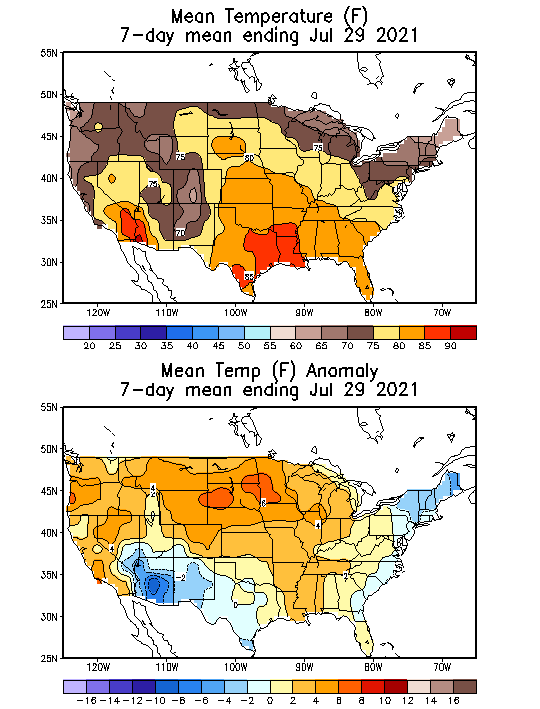
Source: National Oceanic and Atmospheric Administration
Deviation between average and normal (°F)
7-day mean ending Jul 29, 2021

Source: National Oceanic and Atmospheric Administration

